Genome-wide DNA methylation analysis of transient neonatal diabetes type 1 patients with mutations in ZFP57
- PMID: 27075368
- PMCID: PMC4831126
- DOI: 10.1186/s12881-016-0292-4
Genome-wide DNA methylation analysis of transient neonatal diabetes type 1 patients with mutations in ZFP57
Abstract
Background: Transient neonatal diabetes mellitus 1 (TNDM1) is a rare imprinting disorder characterized by intrautering growth retardation and diabetes mellitus usually presenting within the first six weeks of life and resolves by the age of 18 months. However, patients have an increased risk of developing diabetes mellitus type 2 later in life. Transient neonatal diabetes mellitus 1 is caused by overexpression of the maternally imprinted genes PLAGL1 and HYMAI on chromosome 6q24. One of the mechanisms leading to overexpression of the locus is hypomethylation of the maternal allele of PLAGL1 and HYMAI. A subset of patients with maternal hypomethylation at PLAGL1 have hypomethylation at additional imprinted loci throughout the genome, including GRB10, ZIM2 (PEG3), MEST (PEG1), KCNQ1OT1 and NESPAS (GNAS-AS1). About half of the TNDM1 patients carry mutations in ZFP57, a transcription factor involved in establishment and maintenance of methylation of imprinted loci. Our objective was to investigate whether additional regions are aberrantly methylated in ZFP57 mutation carriers.
Methods: Genome-wide DNA methylation analysis was performed on four individuals with homozygous or compound heterozygous ZFP57 mutations, three relatives with heterozygous ZFP57 mutations and five controls. Methylation status of selected regions showing aberrant methylation in the patients was verified using bisulfite-sequencing.
Results: We found large variability among the patients concerning the number and identity of the differentially methylated regions, but more than 60 regions were aberrantly methylated in two or more patients and a novel region within PPP1R13L was found to be hypomethylated in all the patients. The hypomethylated regions in common between the patients are enriched for the ZFP57 DNA binding motif.
Conclusions: We have expanded the epimutational spectrum of TNDM1 associated with ZFP57 mutations and found one novel region within PPP1R13L which is hypomethylated in all TNDM1 patients included in this study. Functional studies of the locus might provide further insight into the etiology of the disease.
Keywords: DNA methylation; Imprinting disorder; Next-generation sequencing; Transient neonatal diabetes.
Figures
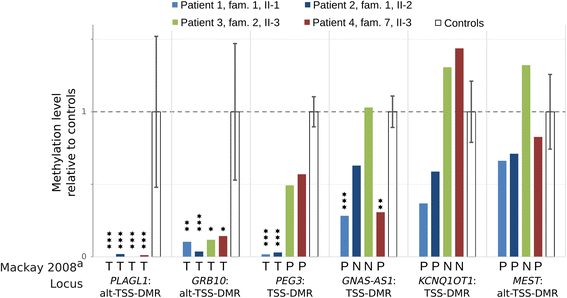
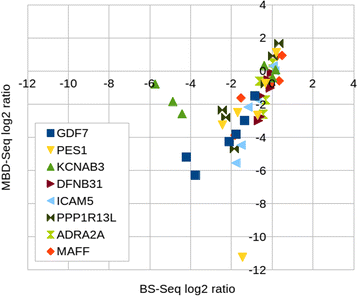
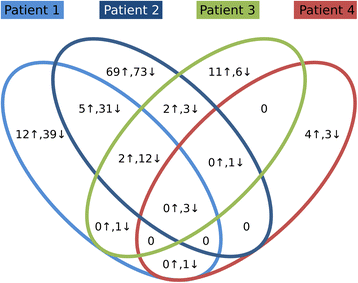
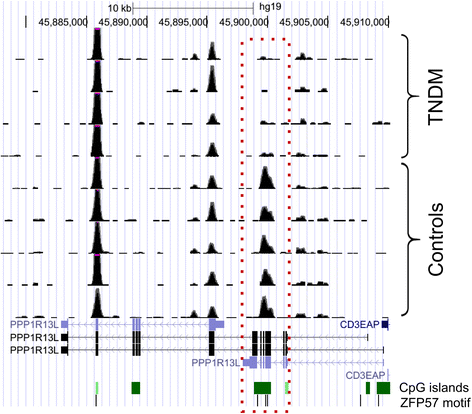
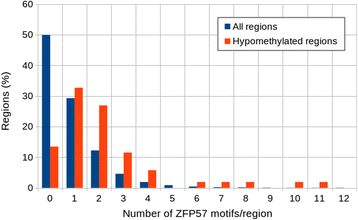
Similar articles
-
Transient neonatal diabetes mellitus and hypomethylation at additional imprinted loci: novel ZFP57 mutation and review on the literature.Acta Diabetol. 2019 Mar;56(3):301-307. doi: 10.1007/s00592-018-1239-3. Epub 2018 Oct 13. Acta Diabetol. 2019. PMID: 30315371 Review.
-
Transient neonatal diabetes mellitus type 1.Am J Med Genet C Semin Med Genet. 2010 Aug 15;154C(3):335-42. doi: 10.1002/ajmg.c.30272. Am J Med Genet C Semin Med Genet. 2010. PMID: 20803656 Review.
-
Transient neonatal diabetes mellitus in a Turkish patient with three novel homozygous variants in the ZFP57 gene.J Clin Res Pediatr Endocrinol. 2013;5(2):125-8. doi: 10.4274/Jcrpe.928. J Clin Res Pediatr Endocrinol. 2013. PMID: 23748067 Free PMC article.
-
Hypomethylation of multiple imprinted loci in individuals with transient neonatal diabetes is associated with mutations in ZFP57.Nat Genet. 2008 Aug;40(8):949-51. doi: 10.1038/ng.187. Epub 2008 Jul 11. Nat Genet. 2008. PMID: 18622393
-
Transient neonatal diabetes, ZFP57, and hypomethylation of multiple imprinted loci: a detailed follow-up.Diabetes Care. 2013 Mar;36(3):505-12. doi: 10.2337/dc12-0700. Epub 2012 Nov 12. Diabetes Care. 2013. PMID: 23150280 Free PMC article.
Cited by
-
Molecular characterisation of 36 multilocus imprinting disturbance (MLID) patients: a comprehensive approach.Clin Epigenetics. 2023 Mar 1;15(1):35. doi: 10.1186/s13148-023-01453-5. Clin Epigenetics. 2023. PMID: 36859312 Free PMC article.
-
Establishment of environmentally sensitive DNA methylation states in the very early human embryo.Sci Adv. 2018 Jul 11;4(7):eaat2624. doi: 10.1126/sciadv.aat2624. eCollection 2018 Jul. Sci Adv. 2018. PMID: 30009262 Free PMC article.
-
Biallelic loss-of-function variants in ZNF142 are associated with a robust DNA methylation signature affecting a limited number of genomic loci.Eur J Hum Genet. 2025 Jul;33(7):896-903. doi: 10.1038/s41431-025-01876-z. Epub 2025 May 23. Eur J Hum Genet. 2025. PMID: 40410387
-
The Bright and Dark Side of DNA Methylation: A Matter of Balance.Cells. 2019 Oct 12;8(10):1243. doi: 10.3390/cells8101243. Cells. 2019. PMID: 31614870 Free PMC article. Review.
-
Gene expression profiles of glomerular endothelial cells support their role in the glomerulopathy of diabetic mice.Kidney Int. 2018 Aug;94(2):326-345. doi: 10.1016/j.kint.2018.02.028. Epub 2018 May 31. Kidney Int. 2018. PMID: 29861058 Free PMC article.
References
-
- Mackay DJG, Callaway JLA, Marks SM, White HE, Acerini CL, Boonen SE, Dayanikli P, Firth HV, Goodship JA, Haemers AP, Hahnemann JMD, Kordonouri O, Masoud AF, Oestergaard E, Storr J, Ellard S, Hattersley AT, Robinson DO, Temple IK. Hypomethylation of multiple imprinted loci in individuals with transient neonatal diabetes is associated with mutations in ZFP57. Nat Genet. 2008;40:949–51. doi: 10.1038/ng.187. - DOI - PubMed
-
- Boonen SE, Mackay DJG, Hahnemann JMD, Docherty L, Grønskov K, Lehmann A, Larsen LG, Haemers AP, Kockaerts Y, Dooms L, Vu DC, Ngoc CTB, Nguyen PB, Kordonouri O, Sundberg F, Dayanikli P, Puthi V, Acerini C, Massoud AF, Tümer Z, Temple IK. Transient neonatal diabetes, ZFP57, and hypomethylation of multiple imprinted loci: a detailed follow-up. Diabetes Care. 2013;36:505–12. doi: 10.2337/dc12-0700. - DOI - PMC - PubMed
Publication types
MeSH terms
Substances
Supplementary concepts
LinkOut - more resources
Full Text Sources
Other Literature Sources
Medical
Miscellaneous

